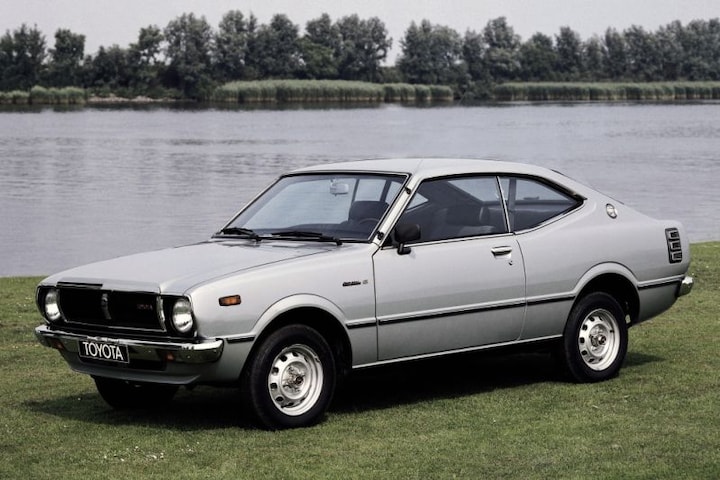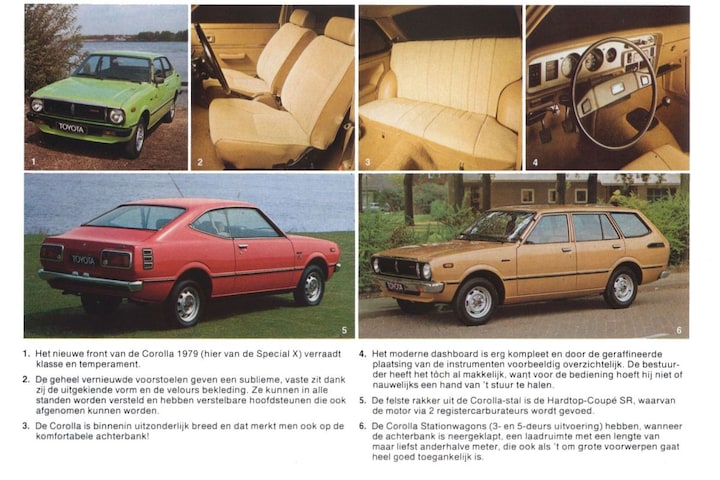Ode to the E30

The rise, breakthrough and ultimate success of the Japanese passenger car cannot be attributed to one manufacturer or one model. But the Toyota Corolla, which saw the light of day in 1974, certainly played an important role in it. The is a combination of the strengths of the Japanese car industry. We put the E30 generation in the spotlight.
What does the Corolla’s approach look like?
The Corolla is already somewhat of an established name when Toyota starts the third generation of its ‘compact mid-sized car’. Better, more spacious, quieter and more luxurious than before are the logical starting points. But at the time of the introduction of the new model, the world economy is in dire straits due to the oil crisis. This has a major impact on the car industry. Good fuel economy is suddenly more important than ever, so this new generation of Corolla arrives at a good time. Not too crazy, not too big and with modest, efficient engines that can keep you going for a long time. But… that turns out not to be enough. Toyota suddenly has to work hard. Just one year after the introduction of the Corolla E30, the engine range has had to be overhauled to ensure that the power sources meet the new emission requirements that come into effect in 1975.

How will he be received by the press and public?
You can safely say that this Corolla represents a big breakthrough for Toyota in the United States, a very large and important export market. But Japan is also flocking to the new Corolla. In the year of its introduction, the model immediately became Japan’s best-selling passenger car. The E30 is a big step forward compared to its predecessor, but car journalists also have some criticisms. They label the Corolla as ‘clunky and heavy’ and ‘less spacious than expected’. Moreover, its starting price is a bit on the high side compared to competitors at the time and the rear suspension of the rear-wheel drive Corolla is described by the journal as ‘simple’. That’s that live axle with leaf springs without a doubt…


How revolutionary is he really?
The third generation of the Corolla is neither groundbreaking nor innovative. But he does a few things very well. The E30 is available in a large number of different body styles and engines, something for everyone. In addition, the Japanese have seriously focused on economical engines that still provide sufficient power. Lean burn technology is introduced at the launch of this generation of Corolla, the principle of achieving maximum efficiency from as little fuel as possible. As early as the 1960s, Toyota set up a serious technical project in Japan, aimed at reducing emissions without sacrificing performance. This acquired knowledge came in handy in 1975, when Toyota had to quickly replace a number of engines in the then very young Corlla with cleaner and more economical power sources. By mid-1975, only a clean 1.4 and 1.6 engine were available for all those Corollas. A modern, clean 1.2-liter, a 1,600 cc four-cylinder and a 1.3-liter engine will be added in the autumn.

The favorite engine of Corolla generation three is the 1,200, or 1,166 cc to be precise. That four-cylinder sewing machine is good for 64 hp. The four-speed gearbox drives the rear wheels and a rigid rear axle with leaf springs must keep everything on the road. Some nice specifications: its family car aspirations are reflected in the dimensions: the length of 3 meters 99. Not small for that time. Weight: 830 kg, a tank capacity of 50 liters, in combination with an average consumption according to the manufacturer’s specifications of 1 in 12.4. The top speed is 145 km/h and the sprint from 0 to 100 takes 14.5 seconds.
What are the choices during the market introduction?
A strong point of ‘the ultimate family car’, as the Japanese called the new Corolla at the time, is its range of versions. We note a two-door or four-door sedan, a two-door coupe, a two-door coupe with hardtop, followed later by a three-door liftback (a kind of stretched hatchback, called Sportswagon), a three-door or five-door station wagon and even a three-door commercial version is available. There is also no shortage of engines in the second instance, with a 1.2-liter, 1.3, 1.4 and two versions of a 1.6-liter engine, with a double overhead camshaft for the faster variant. Shift gears or prefer an automatic? Say it. A four- or five-speed manual gearbox and a two- or three-speed automatic transmission are available. Toyota positions the Corlla E30 as the affordable family car for Jan Modaal. Accessible, reliable and modest. Modesty is part of Japanese culture and it goes without saying that Japanese brands still had a lot of ground to gain in foreign markets in the mid-1970s. But the rise, including that of Toyota, has been unstoppable.


What are the competitors?
We go back to 1974 and how special it is to come across a model that was already the competitor of the Corolla. Then we are talking about the Honda Civic. It was introduced to the market in 1972 and also came to Europe from 1973. Right at the front is a refined, water-cooled four-cylinder engine of 1,200 cc. The Civic is available as a three- and five-door hatchback and as a station wagon. There are also two- and four-door variants with a small tailgate. The first generation Civic lasts until 1979, just like the Corolla. The Civic loses out to the Corolla with its space, because the Honda is just a 3 meter 54 piece. The four- or five-door version (with 1,500 engine) measures up to 3 meters 69. It was not until 1976 that the manufacturer started seriously moving in the direction of family cars with the introduction of the Accord. There is no shortage of refinement in the Civic, because that little Honda does have nice front-wheel drive and the Corolla is far from ready for that in 1974.

Honda Civic

Datsun 120Y
What we no longer encounter in the Netherlands these days is Datsun. But the car division of the large Nissan group has a model that the Corolla has to compete against: the Datsun 1200. In Japan, this is the Corolla’s biggest rival. The model is known there as Nissan Sunny. The Datsun 1200 and the Toyota Corolla are in Japan what the Opel Kadett and the Volkswagen Golf are in Europe at that moment: arch rivals. Just like the Corolla, the Datsun 1200 is also available as a sedan and a station wagon. In 1973, Nissan intensified the battle with the introduction of the 1200 successor, the Datsun 120Y. Quite a cool thing to see and at 3 meters 95 a serious opponent. But the Datsun also has to make do with rear-wheel drive and a rigid rear axle with leaf springs. The 1,171 cc four-cylinder is good for 60 hp and is available in two- and four-door bodies and in the coupe. There is also the 120Y station wagon.
Any details during his life?
The Japanese of that time made a splash with a lot of car for your money and good, reliable technology. The equipment is well organized compared to European competitors, the gearboxes are praised for their direct and precise operation, and the overall ergonomics are widely perceived as good. But the downside is an above-average sensitivity to rust. This generation of Corolla seriously suffers from this, and the same applies to the competitors Honda Civic and Datsun 120Y. In addition, the suspension comfort lags behind the established European cars of the past. The first Civic in particular is a first-class bouncer. In the mid-1970s, Japanese car manufacturers were considerably higher on the status ladder in their home country and even in the United States than in Western Europe. In Japan, Nissan’s Sunny and Toyota’s Corolla coupe in racing trim fight tough duels on the race circuits.
Another special feature is a Corolla from the previous generation, which is not a Toyota: the Daihatsu Charmant. The largest Daihatsu that this oldest Japanese car manufacturer supplied at that time was actually just a Corolla. In Japan, Toyota itself has a Sprinter, which is a sister model of the Corolla coupe, but with a different name. At the end of 1979, the fourth generation of the Corolla made its debut.

Which version appeals most to the imagination?
The Corolla E30 hardly appeals to the imagination. It is simply the reliable and affordable answer to the daily and growing mobility needs of more and more ordinary, average people. Fortunately, Toyota was wise enough to add a coupe to this Corolla family in the 1970s. For the eternal single or couples without a desire to have children. Technically, the coupe adds nothing, its different appearance distinguishes it from its average brothers and sisters. But that is understandable, because Toyota has the Celica (the first generation from 1970-1977) ready for customers who want to take a step higher on the sports ladder. That model also does not offer any technical highlights with its rigid axle with leaf springs at the rear, but the powerful 1.6-liter engine and its striking and very successful body make up for a lot. The larger Carina serves as the basis of the Celica.
What is the impact of the Corolla?
This E30 lays the foundation for the good name and fame of Toyota in general and that of the Corolla in particular in Europe. A good car that you can enjoy without any worries. That pleasure is not so much in the driving experience, but in loyal service, for years, at realistic costs. You get the pleasure from the pleasant service, which you can really enjoy. Switches and buttons feel nice and function smoothly. The Corolla E30 has lived up to what made Toyota famous, loved and successful, even the largest in the world. Just that rust problem…

How many are left?
According to data supplier Vinacles, there are only 13 Corollas of the E30 generation registered with an active license plate in the Netherlands: six sedans, three coupes, three hatchbacks and a station wagon. This has made this Corolla a rarity.
– Thanks for information from Autoweek.nl